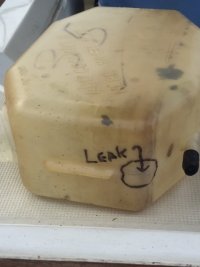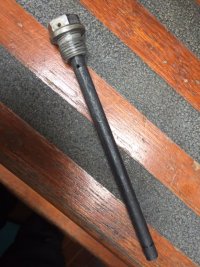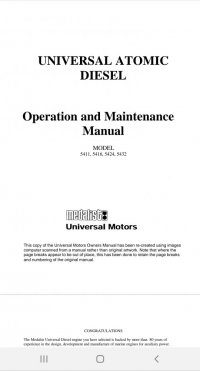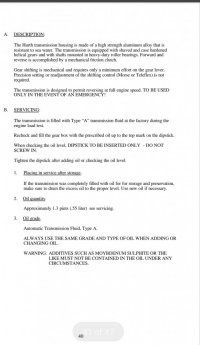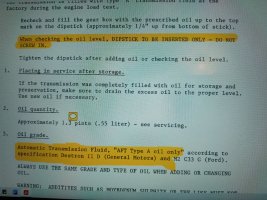1911tex
Sustaining Member
Solution: Went to the boat today for a quick sail; returned and found green antifreeze in the Bilge!! Lordy...here we go again. Checked the engine from front to back, side to side, hoses, clamps, etc. No leaks, no drips ! Noticed the original (I think its original..it was old, had a large very faded "35" written on the side) overflow plastic bottle was empty. Removed it and examined it closely....Photo #1 below illustrates an almost imperceptible open joint...I had to blow in it to verify!
Question: Second photo is the 11/16" (just in case you wanted to know) bolt/dipstick for my original Hurth 50 tranny. When measuring the amount of Dextron III non-synthetic tranny fluid (10oz correct?)....is the correct full level at the groove at the very bottom of the stick?, and is the measure taken with the bolt head sitting on top thread of the hole, or screwed all the way down, then unscrewed to check the fluid level? Reason I ask...I had engines that required measurement taken with dipstick sitting on top of the tube, then pushed home.
Interesting note: The dipstick is hollow with a hole at top, I guess to release fluid pressure inside tube. Why not a solid tube or stick?
Appreciate your kind assistance!
Question: Second photo is the 11/16" (just in case you wanted to know) bolt/dipstick for my original Hurth 50 tranny. When measuring the amount of Dextron III non-synthetic tranny fluid (10oz correct?)....is the correct full level at the groove at the very bottom of the stick?, and is the measure taken with the bolt head sitting on top thread of the hole, or screwed all the way down, then unscrewed to check the fluid level? Reason I ask...I had engines that required measurement taken with dipstick sitting on top of the tube, then pushed home.
Interesting note: The dipstick is hollow with a hole at top, I guess to release fluid pressure inside tube. Why not a solid tube or stick?
Appreciate your kind assistance!

